The Battle of Shiloh was one of the most significant early battles of the American Civil War. Also known as the Battle of Pittsburg Landing, it was fought on April 6–7, 1862 between the Confederate Army of Mississippi led by Generals Albert Sidney Johnston and Pierre G. T. Beauregard; and the Union Army of the Tennessee led by Ulysses S. Grant which was aided by the arrival of Army of the Ohio of Don Carlos Buell. The Confederate plan was to surprise and destroy Grant’s army before it joined forces with Buell’s army. They were able to partially surprise Grant but ultimately the Union forces counter-attacked and forced the Confederate army to retreat marking an important victory for the Union. The Battle of Shiloh was the bloodiest battle in American history up to that point. Know about its events, significance, repercussions and casualties through these 10 interesting facts.
#1 IT WAS PRECEDED BY MAJOR UNION VICTORIES
In the period just before the Battle of Shiloh, the Union forces under Gen. Ulysses S. Grant captured the Confederate forts, Fort Henry and Fort Donelson. A historian considers these victories as the “first significant Union triumph in the war”. The successful Henry-Donelson campaign secured Kentucky and parts of Tennessee for the Union. Grant’s divisions which took part in the campaign soon formed the core of the famed Army of the Tennessee, which would be involved in most of the great battles of the war. The next objective for the Union forces was to capture Corinth, a vital rail center that would give them total control of the region. Meanwhile, after the losses of forts Henry and Donelson, Confederate General Albert Sidney Johnston established his base at Corinth, Mississippi. His reorganized force, which numbered around 55,000 men, was named the Army of Mississippi.
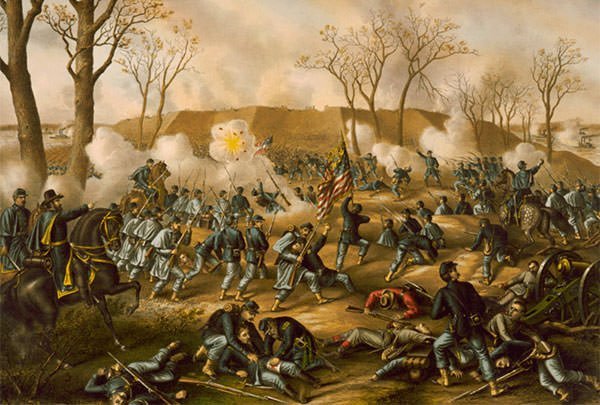
#2 THE TWO NAMES FOR THE BATTLE CAN BE TRACED TO A BIBLICAL CITY AND AN OWNER OF A TAVERN
Union Maj. Gen. Henry W. Halleck ordered Grant to move his troops up the Tennessee River, where he was to wait for the arrival of Maj. Gen. Don Carlos Buell’s Army of the Ohio. The six divisions of Grant’s Army of the Tennessee consisted of around 45,000 men and were led by John A. McClernand, W. H. L. Wallace, Lew Wallace, Stephen A. Hurlbut, William T. Sherman and Benjamin M. Prentiss. Apart from Lew Wallace’s 3rd Division, which was at Crump’s Landing, the remaining five divisions encamped at Pittsburg Landing, Tennessee, on the west bank of the river. The place got its name from “Pitts” Tucker who operated a tavern at the site in the years preceding the Civil War. Many of Grant’s men surrounded a small, log meetinghouse named Shiloh Church. Shiloh was an important biblical city in Israel after which several churches have been named.

#3 THE CONFEDERATE ARMY INTENDED TO LAUNCH THE ATTACK ON APRIL 4
Confederate General Albert Johnston departed from Corinth with around 40,000 men on 3rd April with the aim to surprise Grant’s men before the arrival of Buell’s army. His four large corps were led by Leonidas Polk, Braxton Bragg, William J. Hardee and John C. Breckinridge. The original plan was to launch an attack on April 4 but it was delayed due to heavy rains, which also slowed Buell’s army. There were minor skirmishes between the two forces in the days leading to the battle. However, Ulysses S. Grant didn’t want to engage in a fight before the arrival of Buell’s army and had ordered his frontline division commanders Sherman and Prentiss not to spark a fight. Due to the skirmishes, the Union men were aware that Confederate forces were nearby but they didn’t know their strength. Also, order from their superiors to avoid engagement led them to neglect intelligence that a sizable Confederate army could launch an attack on them.
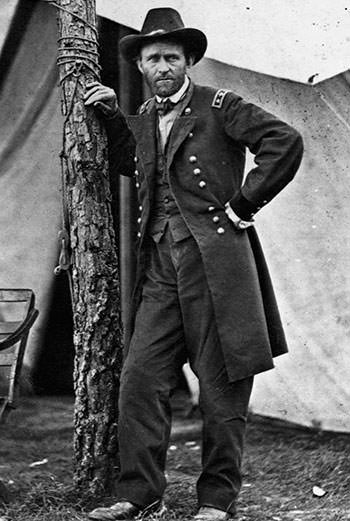
#4 TACTICAL SURPRISE WHICH JOHNSTON WANTED TO ACHIEVE WAS THWARTED BY COL PEABODY
Around 3 am on Sunday, April 6, 1862, one of the brigade commanders of the 6th division of Prentiss, Col. Everett Peabody, sent out a patrol of 250 infantry men. He did so in defiance of the orders of Prentiss as reports of contacts convinced him that there was a strong possibility of a large confederate force in the area. When Prentiss found out what Peabody had done, he told his subordinate he would hold him personally responsible for bringing on a battle earlier than intended. At dawn, the patrol sent by Peabody located the Confederate army. They warned the Union army a short while before the attack and thus prevented the total tactical surprise the Confederates wanted to achieve. As the frontline division commanders Sherman and Prentiss realized that they were facing an assault by an entire Confederate army, they rushed to prepare their men for defense.
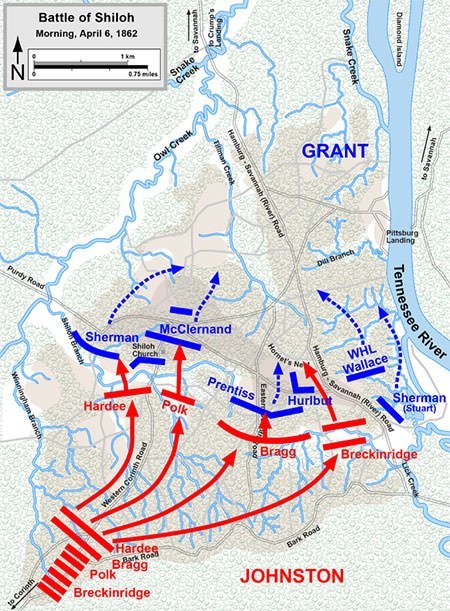
#5 THE DIVISIONS OF PRENTISS AND WALLACE CRUCIALLY DEFENDED HORNET’S NEST FOR 7 HOURS
The Confederate assault was ferocious and many Union regiments fragmented entirely. One of the main Union defensive line, starting around 9 am, was at a position nicknamed the “Hornet’s Nest”, in a field along a road, now popularly called the “Sunken Road”. The division of Prentiss began defending that position with around 5,400 men but they soon dwindled to around 500. It was aided by the arrival of the division of W. H. L. Wallace. The two divisions held Hornet’s Nest for seven hours before Prentiss surrendered to the Confederates. However, their sacrifice bought Grant valuable time to establish a final defense line near Pittsburg Landing. W. H. L. Wallace was mortally wounded during the confrontation. The famous Sunken Road was actually not sunken at the time and the term was first used much later in 1881. As it became a popular tourist attraction, the volume of people passing on it made it reach a depth of several feet and thus the myth became a reality.
#6 ALBERT S. JOHNSTON WAS THE HIGHEST RANKING OFFICER KILLED DURING THE CIVIL WAR
During the confrontation at Hornet’s Nest, Confederate commanding general Albert Sidney Johnston was shot in his right leg. As he thought the wound was insignificant, he sent his personal surgeon to care for wounded Confederates, and Union soldiers they had captured. When his staff members found him slumping in his saddle, they laid him down against a tree and went to fetch a surgeon. However, before a doctor could be found, Johnston bled to death due to a torn artery. General Pierre G. T. Beauregard assumed control of the Confederate forces. He ordered Johnston’s body to be hid to prevent damaging the morale of his troops. Confederate President Jefferson Davis considered Johnston to be the most effective general they had at the time and thus his death was a major blow to the Confederate cause. Albert S. Johnston was the highest-ranking officer from either side to be killed in combat during the entire American Civil War.
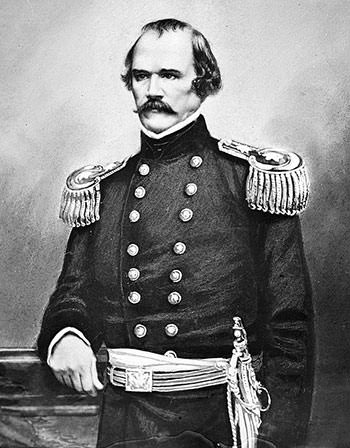
#7 CONFEDERATE ARMY HAD THE UPPER HAND ON APRIL 6 BUT COULDN’T ACHIEVE AN OUTRIGHT VICTORY
After Hornet’s Nest fell, the remnants of the Union forces established a solid three-mile front around Pittsburg Landing. The final charge of the Confederates attempted to break through the line but was repulsed. Beauregard controversially called off the assault at dusk. Though for years after the battle he was blamed for not capitalizing on an advantageous position, later historians believe that Grant had his ground covered anyway. The Confederates had driven the Union forces back 2 miles towards Pittsburg Landing but couldn’t break them. William T. Sherman, who had been negligent regarding the imminence of the Confederate attack, rallied his division and conducted an orderly, fighting retreat. He emerged as one of the heroes of the battle. After the first day, Sherman encountered Grant standing under a tree, smoking a cigar. He remarked, “Well, Grant, we’ve had the devil’s own day, haven’t we?” Grant looked up. “Yes,” he replied, followed by a puff. “Yes. Lick ’em tomorrow, though.”
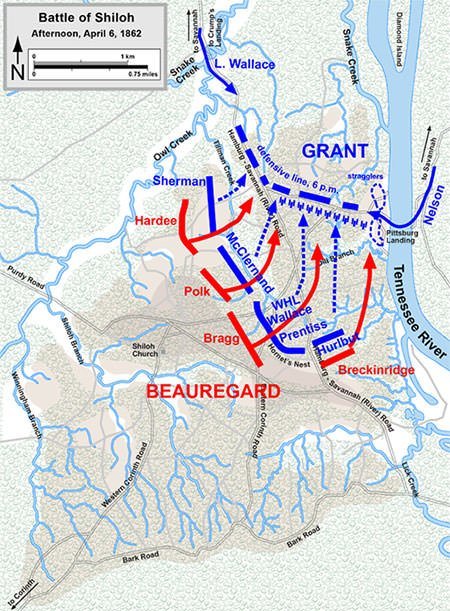
#8 THE UNION FORCES COUNTERATTACKED ON APRIL 7 FORCING THE CONFEDERATES TO RETREAT
Don Carlos Buell’s Army of the Ohio had arrived on April 6. The reinforced Union army now numbered around 45,000 men while the Confederate strength had been depleted from 40,000 to less than 30,000 due to casualties. With an advantage in numbers, Ulysses S. Grant launched a massive counter-attack at dawn on April 7. After heavy fighting, the Hornet’s Nest area was recaptured by the Union forces by late morning. In early afternoon, Beauregard launched a series of counterattacks from the Shiloh Church area which pushed back the Union forces, but only temporarily. Realizing that he had been outnumbered and was low on ammunition, he soon ordered a retreat, leaving a covering force of around 5,000. Due to the exhaustion of his troops, Grant didn’t order an immediate pursuit. The Battle of Shiloh was a major victory for the Union forces
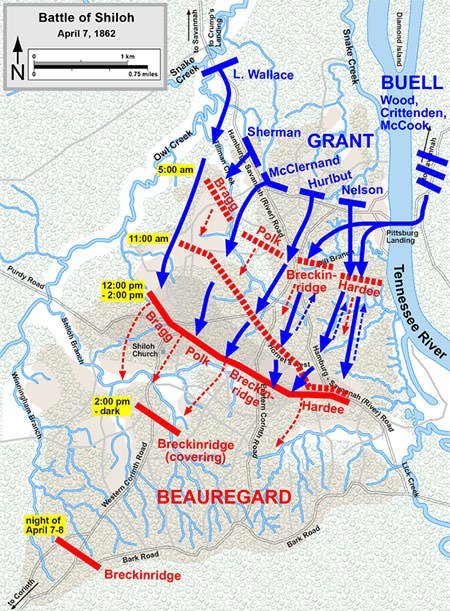
#9 THE BATTLE OF SHILOH WAS THE BLOODIEST BATTLE IN US HISTORY UP TO THAT POINT
Union casualties in the Battle of Shiloh were 13,047 (1,754 killed, 8,408 wounded, and 2,885 missing) while the Confederate casualties were 10,699 (1,728 killed, 8,012 wounded, and 959 missing or captured). With 23,746 casualties, the Battle of Shiloh was the bloodiest battle in American history up to that time. Three more years of the Civil War would go on to see eight larger and bloodier battles. The Battle of Gettysburg would become the deadliest battle of the war with casualties between 46,000 and 51,000. Albert S. Johnston was the highest ranking Confederate officer killed at the Battle of Shiloh while W. H. L. Wallace was the highest ranking Union officer who was killed. Colonel Everett Peabody, who probably saved the Union from defeat through his timely patrol, was also among the men who perished during the costly battle.
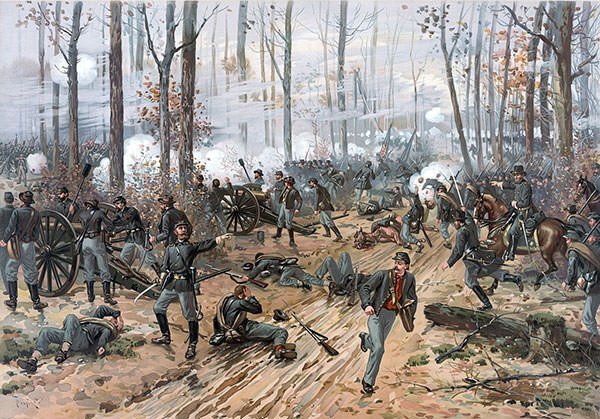
#10 ULYSSES S GRANT WAS BLAMED BY THE UNION PRESS DESPITE HIS VICTORY AT SHILOH
After the Battle of Shiloh, Gen. Grant was vilified by the press for his lack of preparedness. There were calls for his removal but President Abraham Lincoln replied with one of his most famous quotations about Grant: “I can’t spare this man; he fights.” Nevertheless, Grant’s superior Union Maj. Gen. Henry W. Halleck arrived at Pittsburg Landing to take command in the field and relegated Grant to the powerless position of second-in-command. Union army under Halleck would go on to capture the town of Corinth in late May. Ulysses S. Grant would ultimately become the Commanding General of the US Army in 1864 and the 18th President of the United States in 1869. Confederate President Jefferson Davis was outraged at Beauregard for withdrawing from Corinth and re-assigned him to oversee the coastal defenses in South Carolina. The US Postal Service released a commemorative stamp on the 100th anniversary of the Battle of Shiloh on April 7, 1962.
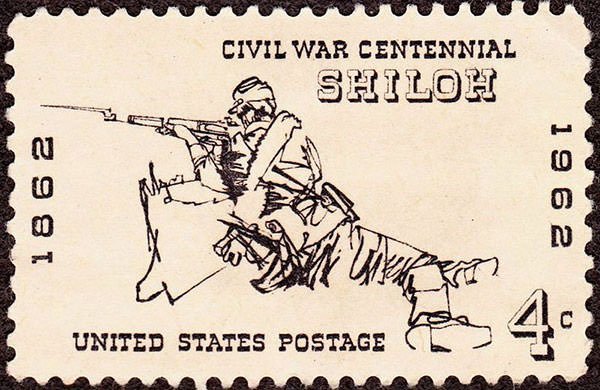
BATTLE OF SHILOH AND LEW WALLACE
Major General Lewis “Lew” Wallace was a rising star in the Union army. At Battle of Shiloh, he was the leader of 3rd Division, stationed at Crump’s Landing. After the Confederates attacked, Grant ordered Wallace to move his troops to the front to support Sherman’s division at Shiloh Church. Of the two available routes, Wallace took the northern one and upon his arrival found that he had to either fight through the Confederate rear to reach the Union forces or to reverse his direction and find another way. Wallace took the second option and when he arrived at the Union camp, much of the battle for the day was over. Wallace claimed he was not told which route to take while Grant said he had ordered him to take the southern route. The reputation of Lew Wallace was irreparably damaged after the incident and his military career was severely affected. Lew Wallace would later become a renowned writer through his 1880 best-selling novel Ben-Hur: A Tale of the Christ, considered as “the most influential Christian book of the 19th century”.

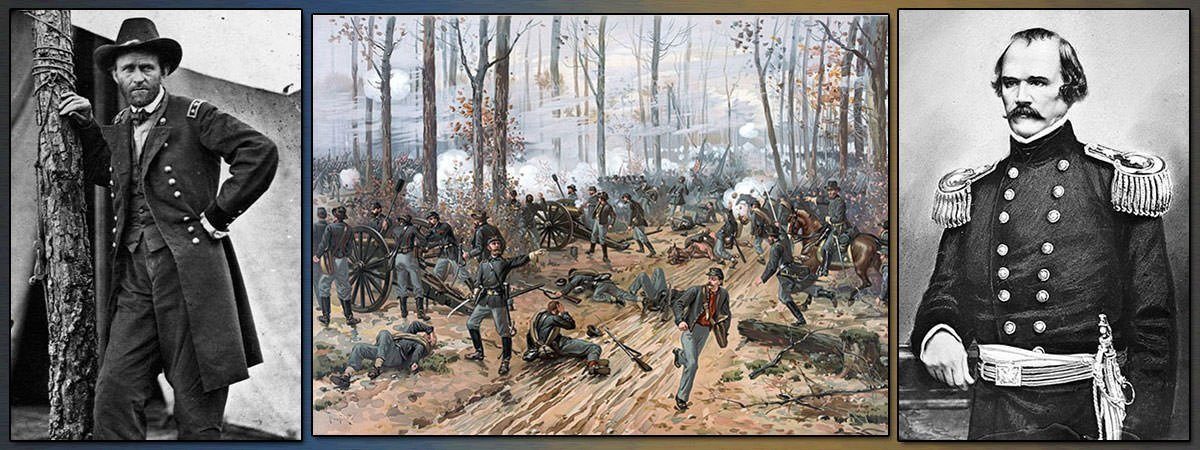
Very helpful! Thank you!
Happy to help.
who won this battle
I am genuinely glad to read this web site posts which contains lots of useful facts, thanks for providing such
statistics.